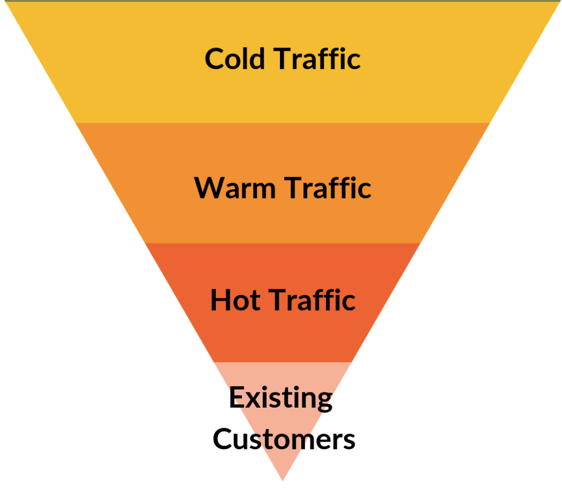
Acquiring new customers, client, and/or leads is one of the greatest challenges we face as marketers in the digital age. It’s not enough to simply have a fantastic product or service to sell. We need to let people know about it. More specifically, we need to bring it to the attention of those who are most likely to benefit from it.
Social media offers us an abundance of opportunities to connect with potential customers. But with so many platforms to choose from and so many other marketers out there competing for those potential customers’ attention, these can e tricky waters to navigate. In this article, we’ll attempt to set you on the right course.
Join the Accepted Platinum Credit Card Rewards Program!
Table of Contents
What Is Targeted Traffic?
Targeted traffic is that which falls into a set of perameters that you have determined make up the ideal avatar for a customer with the desire and means to pay for your product or service. Simply put, if you own a cheese shop, your target audience is made up of people who are hungry for some cheese.
Let’s use an example to make it easy to understand. We’ll go with an offline business, but the same applies to online business as well.
Imagine you own a small brick-and-mortar shop that sells various types of cheese. Everyone loves cheese. You stock hundreds of types of cheese, from classic cheddar to gourmet Tibetan yak cheese.
Your primary customer would be people who like to cook at home and experiment with various types of food.
Potential customers range from cold to hot as show in this inverted pyramid.

- Cold Traffic: A guy was walking across the street and saw your shop. This person represents a cold audience. He doesn’t know who you are and whether he can trust you yet. He’s probably not even thinking about cheese right now.
- Warm Traffic: A couple of days later, this same person walks past your shop again. He’s still not necessarily in a cheese-purchasing frame of mind, but he catches a whiff of gorgonzola that piques his curiosity. He decides to step inside and see what you have to offer. He doesn’t buy anything, but he gets a good idea of what he can expect from you and your business.
- Hot Traffic: A few weeks later, this guy is in a mood to bake some pizza at home, and he needs cheese urgently. What’s the first place that comes to his mind? Yours. He sprints back to your store and becomes your customer.
- Repeat Traffic: So impressed is this man by the quality of your cheeses, the wide variety of cheeses you keep in stock, your reasonable prices, your excellent customer service, and your extensive knowledge of cheese, that he becomes a regualr customer. For the rest of his life, when he has a problem that can only be solved by a soft, creamy wedge of camembert, yours is the shop he keeps coming back to.
A business needs to make a profit. To make profits, you need more and more customers. Pretty simple.
Your business will need to overcome two problems to grow.
- Draw the attention of as warm an audience as you can.
- Convert that audience into repeat customers.
Solve these two, and you’re well on your way to giving your business the highest chance of success. That’s where targeted traffic comes in.
In our cheese shop example, our ideal customer is someone aged 20-40. They like to cook and own an oven. They follow YouTube channels related to cooking. They may even have kids and want to experiment with different recipes often.
So, if you target a mom who is 35, has kids, watches MasterChef, and follows cooking-related food channels, you are more likely to convince her to become a customer than a 75 year old man who doesn’t shop for himself and follows a strict diet.
The problem then becomes how to reach thousands of such people for as little money as possible.
How do you target these mothers who like to cook specifically without wasting your time and money on people who are far less likely to become your customer?
How is Targeted Traffic Better than Regular Traffic?
A targeted audience is one that you know is more likely to convert to a paid customer down the road. The more often they see your store, the more often they get a chance to interact with it. Eventually, some of them will make a purchase.
In continuation to our original cheese stop story: Before opening your brick-and-mortar store, you need to decide on the location. Where you open your shop is crucial to your success.
You would want to focus on a locality where people have enough disposable income to buy cheese. You would prefer to open it near grocery stores and away from gyms. You want to get closer to your target audience.
Opening it near a school, where moms often go to pick up their kids, might be a good idea. You want to be as convenient as you can be so that your ideal customer can reach you easily, multiple times. The more opportunities they have to interact, the more they will be likely to purchase.
Similarly, on social media, you need to be present at all the right places. Your target audience must see you repeatedly and engage with you.
Targeted Traffic Math
People in your targeted demographics need less convincing than colder audiences. You can persuade them into becoming customers faster.
But the more limited your targeting is, the more difficult (and expensive) it gets to target them.
So you need to balance the size of the audience and the cost to reach them. Like most skills, this becomes easier with trial and error.
Now that the basics are clear, let’s get started!
How to Use Social Media to Get Targeted Traffic
Social Media is a game-changer. It allows you to target potential customers based on their personal data and interests. Do you need to target a stay-at-home mom who likes to cook? Facebook has a list of a million such people near you.
Not only you can target with laser precision, but it also shows how many times an average person saw your content online before becoming your customer. You can enter the mind of the consumer and analyze how to improve your business.
5 Steps You Should Follow When Using Social Media To Drive Traffic To Your Business
You don’t need to have an online business to use social media for marketing. It is viable for all types of business. Our brick-and-mortar cheese shop can use social media to drive traffic to thier shop just as effectively as someone with an online Print on Demand business.
1. Use Multiple Platforms
An average internet user has more than one social media handle, and so should you. Figure out which platforms are frequented by your target demographics and learn how to use them.
- If you want to target the younger generation and teenagers, you should consider Tik-Tok and Snapchat.
- If your target audience is typically between 20-40, Instagram, Facebook and Twitter are popular choices.
- If your target audience is people with jobs and you want to target based on their work description and industry, LinkedIn is what you need.
Don’t restrict yourself to one platform. Keep on experimenting with new platforms and content.
However, some platforms are better than others. Images and videos often see a higher conversion rate than plain-old text.
Data suggests that 1 in every 3 Facebook users will buy from the platform, so do not hold onto the notion that Facebook is dead.
2. Post Content Regularly
To drive online sales, you need to be omnipresent. Social Media companies reward accounts that post frequently with more traffic. You need to create fresh content every day, perhaps even multiple times a day. This is harder than it sounds and you may need to outsource your content to someone else.
You need to create content that your ideal customer is interested in, which helps them interact with your business and form meaningful connections.
For our cheese shop, you could post videos and reels of how to use cheese in various recipes ever so often. Tell the world about the types of cheese you have, and how you make them. Give them an inside-look of your shop, as long as it is entertaining. In this influencer-driven economy, people are lonelier than ever. Involve people in your business. Make them feel like they matter.
If you are a local business, post content that concerns your locality. Build a community of local followers.
Data suggests that 1 in every 3 Facebook users will buy from the platform, so do not hold onto the notion that Facebook is dead.
Remember to engage with them. Reply to their comments, answer their queries and thank them for their business. The more you engage, the more the social media algorithm rewards you.
When posting content on social media, both quality and quantity are keys to success.
3. Keep an Open Mind and be Ready to Adapt
You have an idea of what your ideal customer looks like, but as you get started on social media and start seeing the results, you might realize that your ideal customer is a little different from what you had previously imagined. Sometimes, you might even find that you were way off!
Maybe you’ll notice that the majority of those interacting with your posts aren’t moms, but rather teenagers.
You need to be open to possibilities and willing to learn from the data and the facts before you.
Always keep analyzing your results, and pivot when you need to. Only the fittest survive.
4. Search Engine Optimization
If you don’t know what SEO is, don’t worry. We’ve got you covered.
In simple terms, when people search for something on Google, YouTube or Amazon, they tend to click on one of the first few results. Everything beyond that gets lost to obscurity.
Those coveted top few results are constantly changing, depending on various algorithms. They factor in the loading speed of your website, ease of use, how many visitors you are getting and how much time they spend on your site, as well as hundreds of other factors.
You want to be in the top few results for relevant search terms to get the attention of the masses. This not only applies to major search engines, but for a variety of searchable social media platforms as well. While the platforms are all different, your goal remains the same.
When someone types “Buy Fresh Parmesan Cheese” you should be the first search result they see.
So how do you rank on top? You need to make your content SEO friendly. Give the algorithms what they want.
If you’re not particularly tech-savvy, this can be easier said than done. In that case, you can either learn by constant trial and error, educate yourself with courses or online tutorials, or outsource your social media presence to a company that specializes in running the social media accounts of busy people like yourself who want to focus more on their businesses.
But before you go and start spending money on SEO, know that success with social media is slow and organic. It takes time to build a substantial following and get your content ranked.
5. Paid Ads
Young businesses often make the mistake of starting their social media marketing campaigns with paid ads. Using Paid Ads should be the final step after you have accumulated data and identified your customers.
Advertising is a double-edged sword, and one you’ll want to take great care and consideration before wielding.
If you don’t k now what you’re doing, advertising on social media platforms can get expensive. You can easily find yourself paying high prices for clicks with no guarantee that the person who clicked is going to go on to buy whatever you’re selling.
On the other hand, if you know what you’re doing, paid ads can be the most powerful weapon in your marketing arsenal. One successfully scalable campaign has the power to quickly transform a loss-making business into a multi-million dollar enterprise.
These results, of course, are far from typical. But small-scale successes can also add up to big results over time.
Before you start spending money on ads, it’s important to learn what’s already working for you. Amplifying current success is a lot easier (and cheaper) than throwing a bunch of spaghetti at the wall and seeing what sticks.
Take the time and put in the effort to post engaging content. Learn for yourself what gets the most engagement and leads to more sales. Once you have a thorough understanding of what works for you and your business, then you can start experimenting with paid traffic.



